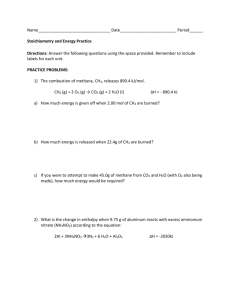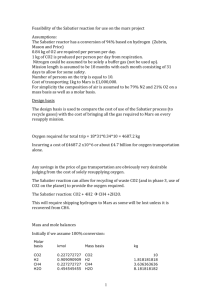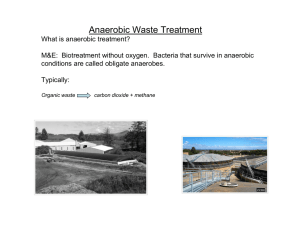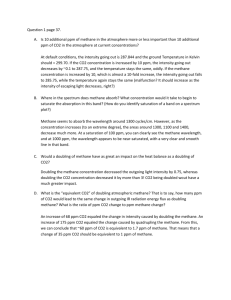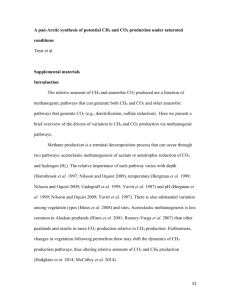GAS ANALYSIS
advertisement
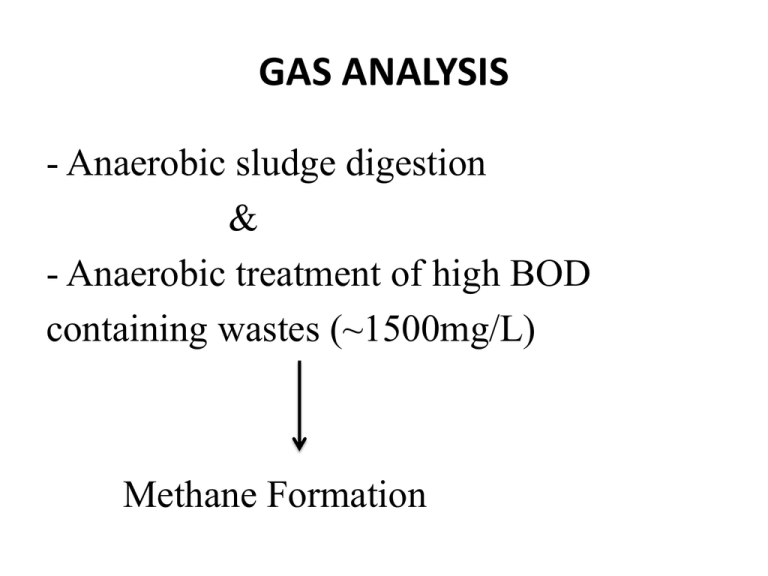
GAS ANALYSIS - Anaerobic sludge digestion & - Anaerobic treatment of high BOD containing wastes (~1500mg/L) Methane Formation Gas produced contains; CO2 CH4 N2 H2S 33-38% 55-65% • Heating value: 600 Btu / ft3 (5330 kcal/m3 ) • Anaerobic digester can be heated with this energy. • Heating value depends on the waste strength. • Composition of the gas is related with conditions in the reactor. CO2 / CH4 ratio Character of the substrate Analyze the gases produced *Determine fuel value * Monitor treatment * If CO2 content increases indicates trouble in anaerobic treatment * H concentration should be low, high H Digester upset Methods of Analysis Volumetric Procedure : (Simple Method) Orsat Apparatus is used O2 , CH4, H2, CO2, N2 Gas Chromatography : Advantage : speed CH4 ,CO2 , air (N2 + O2 ) Gas Chromatography • Previously calibrated for each gas • Suitable for routine work, frequent analysis • TCD (Thermo Conductivity Detector) is used in GC for gas analysis Volumetric Analysis • Combustion of hydrogen and methane Measure amount of CO2 produced during combustion • If hydrogen and methane burned together Possibility of explosion Volumetric Analysis (continue) Separate oxidation of H2 and CH4 * Hydrogen oxidized by passing the gas through a heated unit charged with cupric oxide * Methane is oxidized by bringing it and O2 with a catalyst at a lower temperature. CO2 • Take 100 mL sample, contact with a solution of KOH CO2 + 2KOH K2CO3 + H2O Potassium Carbonate CO2 (Continue) CO2 disappears from the gaseous phase Volume reduction = V CO2 Hydrogen Sulfide H2S + 2KOH K2S + 2H2O Volume of H2S is too small, can be ignored O2 * Very little possibility of O2 existence in anaerobic digester gas. Can enter during sampling. * If more than 0.1-0.2 % Indicates poor sampling technique O2 (continue) * Measured by using alkaline pyrogallol Under alkaline condition pyrogallol (1,2,3-trihydroxy-benzene) is oxidized by oxygen * Measure CO2 . Volume reduction = VO2 (CO2 present should be removed previously) Hydrogen * Pass the gas mixture over cupric oxide @ 290-300 o C * H2 is oxidized to water (methane is not) Water vapor formed condenses at lower temperature Cool the sample Measure volume loss after contact with heated cupric oxide Methane * After removal of hydrogen oxidize methane by slow combustion or catalytic oxidation * Stoichiometry is important to calculate required amount of O2 for combustion CH4 + 2 O2 CO2 + 2H2O Nitrogen Inert gas VN2 = VT - (VCO2 + VO2 + VH2 + VCH4 ) Collection - Storage *Glass / metal tubes *Gum – rubber balloons ( Pervious to H2 and CH4 !!) Use displacing fluid to transfer the gas sample to the apparatus Collection - Storage Temperature changes affect the analysis. If combustion is applied, measure gas volume after the temperature returns to original value. Collection- Storage Confining liquid: • Hg (ideal, but have health hazards, used in precise inst) Water Solvent power Aqueous solution 20% Sodium sulfate, 5% H2SO4 Hydrogen Sulfide H2S corrosive • If gas will be used as a fuel, should contain < 1.14 mg/L H2S + I 2 2HI + S • Excess iodine is indicated with starch indicator.

